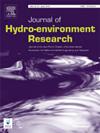Impacts of climate change on the South Asian monsoon: A comprehensive review of its variability and future projections
IF 2.3
3区 环境科学与生态学
Q2 ENGINEERING, CIVIL
引用次数: 0
Abstract
The South Asian monsoon is a critical climatic phenomenon that sustains the livelihoods of nearly two billion people, who rely on its rainfall for agriculture, water resources, and economic stability. In this context, this paper reviews the impact of climate change on this crucial system, focusing on its dynamics, variability, and future projections. Based on past studies, this study examines observed changes in rainfall during the second half of the 20th century and compares these changes with model projections for the 21st century. The findings suggest that ocean-land temperature gradients, atmospheric circulation, and regional topography interact intricately to influence monsoon behavior. Rising global temperatures are expected to enhance total rainfall due to increased atmospheric moisture, but concerns remain about the potential weakening of monsoon circulation. This raises the critical question of how the projected increase in atmospheric moisture will impact overall rainfall patterns, including intensity, duration, and timing. Another key finding is the role of aerosols in monsoon variability, leading to the question of how aerosol emissions might influence the variability and dynamics of the South Asian monsoon and how these impacts compare to those of greenhouse gases. Given the current limitations in climate models, observational networks, and data analysis, substantial improvements are needed for more accurate future projections of monsoon variability, particularly in terms of monsoon circulation and extreme weather events. Addressing these challenges will be crucial for developing effective adaptation strategies to mitigate the impact of climate change on the South Asian monsoon and to ensure resilience and sustainability in agriculture, water resources, and the regional economy.
气候变化对南亚季风的影响:对其变率和未来预测的全面回顾
南亚季风是一种重要的气候现象,维持着近20亿人的生计,他们的农业、水资源和经济稳定都依赖于南亚季风的降雨。在此背景下,本文回顾了气候变化对这一关键系统的影响,重点关注其动态、变率和未来预测。在过去研究的基础上,本研究考察了20世纪下半叶观测到的降雨变化,并将这些变化与模式预估的21世纪进行了比较。研究结果表明,海洋-陆地温度梯度、大气环流和区域地形复杂地相互作用,影响季风行为。由于大气湿度增加,全球气温上升预计将增加总降雨量,但人们仍然担心季风环流可能减弱。这就提出了一个关键问题,即预计的大气湿度增加将如何影响整体降雨模式,包括强度、持续时间和时间。另一个重要发现是气溶胶在季风变异性中的作用,这导致了气溶胶排放如何影响南亚季风的变异性和动力学以及这些影响与温室气体的影响相比如何的问题。鉴于目前气候模式、观测网络和数据分析的局限性,需要进行实质性的改进,以便更准确地预测季风变率,特别是在季风环流和极端天气事件方面。应对这些挑战对于制定有效的适应战略至关重要,以减轻气候变化对南亚季风的影响,并确保农业、水资源和区域经济的复原力和可持续性。
本文章由计算机程序翻译,如有差异,请以英文原文为准。
求助全文
约1分钟内获得全文
求助全文
来源期刊

Journal of Hydro-environment Research
ENGINEERING, CIVIL-ENVIRONMENTAL SCIENCES
CiteScore
5.80
自引率
0.00%
发文量
34
审稿时长
98 days
期刊介绍:
The journal aims to provide an international platform for the dissemination of research and engineering applications related to water and hydraulic problems in the Asia-Pacific region. The journal provides a wide distribution at affordable subscription rate, as well as a rapid reviewing and publication time. The journal particularly encourages papers from young researchers.
Papers that require extensive language editing, qualify for editorial assistance with American Journal Experts, a Language Editing Company that Elsevier recommends. Authors submitting to this journal are entitled to a 10% discount.
 求助内容:
求助内容: 应助结果提醒方式:
应助结果提醒方式:


